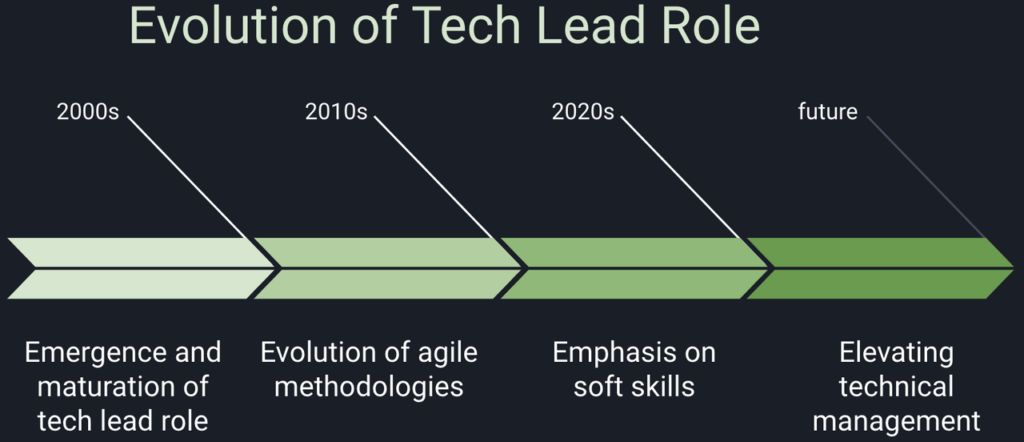Article

How to Evolve from Being a Leader to a Technocrat?
In the fast-evolving realm of technology-driven enterprises, leadership has taken on a new dimension. No longer confined to traditional managerial roles, today’s technology leaders must adeptly navigate the intersection of innovation, human capital, and strategic foresight.
In an era where every industry is shaped by technological advancements, the role of a technology leader becomes indispensable. They are tasked not only with driving product delivery and operational efficiency but also with foreseeing and integrating emerging technologies that propel organizational growth.
This article explores the pivotal role of technology leadership in contemporary corporate landscapes, addressing its multifaceted responsibilities, evolving styles, and the imperative for continuous adaptation.
Evolving role of tech leadership: The intersection of innovation and management
In the contemporary landscape of business, where technology permeates every facet of operations and strategy, the figure of the technology leader has emerged as a linchpin in the machinery of success. In the tech-driven world, the most successful technology leaders are those who can merge the visionary aspects of leadership with the technical acumen of a technocrat.

[Image Source: LinkedIn]
They must not only manage and inspire their teams but also stay intimately involved with the technological elements that drive their business forward. Balancing these roles is both an art and a science, requiring a deep understanding of both human and technological dynamics.
A technology leader is tasked with more than just overseeing the technical operations of a company. Their role involves crafting a technology-driven workflow that aligns with the company’s mission and market demands. This requires a nuanced understanding of several key factors:
At its core, effective technology leadership demands a keen awareness of external dynamics:
- Market trends and technological developments: Staying attuned to market shifts and emerging technologies is foundational. Leaders must discern which innovations align with corporate strategy, fostering a competitive edge.
- Competitive landscape: Understanding rivals’ technological advancements enables proactive strategies, ensuring the organization remains ahead of industry benchmarks.
- Rapid technological evolution: Embracing continuous improvement is crucial. Leaders must cultivate an environment conducive to ongoing innovation and refinement.
Internally, technology leaders play a pivotal role in bridging the gap between technological capabilities and operational deployment:
- Process integration: Successful integration of new technologies hinges on comprehensive understanding across the organization. Clear communication and training are vital to ensuring seamless adoption and efficiency gains.
- Team engagement: Effective leadership entails not only directing but also listening. Technology leaders must actively solicit and incorporate feedback from teams, fostering a collaborative environment conducive to problem-solving and innovation.
Assessing the key styles of technology leadership
The approach to technology leadership varies based on organizational needs and technological intensity. In the ever-shifting landscape of technology, leaders adopt various styles to steer their organizations toward innovation and growth. These leadership styles—Owner, Enabler, Influencer, and Challenger—each play a crucial role in shaping how technology is developed, integrated, and utilized.

[Image Source: McKinsey]
1. Owner: Driving tech development and innovation
Engaged in every aspect of technological development. They not only steer their organizations but actively participate in shaping technological strategies and innovations.
We can take example of Elon Mask. Under Musk’s leadership, Tesla has pioneered advancements in electric vehicles, battery technology, and autonomous driving. His direct involvement in product development and relentless pursuit of innovation have redefined the automotive industry. Musk’s vision for SpaceX, including reusable rockets and Mars colonization, has transformed space exploration and set new benchmarks in aerospace technology.
2. Enabler: Facilitating technology integration
Enabler leaders are integral to the technology landscape as they focus on facilitating the seamless integration of new technologies into organizational workflows. They prioritize the development of supportive infrastructure, streamlined processes, and robust support systems to ensure that technological innovations can be implemented without friction. Their goal is to remove obstacles to technology adoption and create an environment that promotes efficiency and effectiveness.
Satya Nadella’s leadership at Microsoft indeed exemplifies the principles of an enabler leader. Under Satya Nadella’s leadership, Microsoft has undergone a significant transformation towards cloud computing and artificial intelligence. Nadella’s focus on enabling technology integration is evident in the expansion and enhancement of Azure, Microsoft’s cloud platform. He has overseen the development of robust infrastructure to support Azure’s growth, ensuring that it meets the needs of a diverse range of customers.
Similarly As CEO of Oracle, Safra Catz has played a crucial role in enabling technological integration within the company. Catz’s leadership has been marked by a strong emphasis on developing and supporting Oracle’s cloud infrastructure. Her focus on streamlining processes and providing the necessary resources for effective technology adoption has been key to Oracle’s success in expanding its cloud offerings and improving operational efficiency.
3. Influencer: Guiding teams towards new methodologies
Influencer leaders act as catalysts for technology adoption within their organizations. They provide support and act as sounding boards for individuals and teams who are driving technological initiatives. By championing new technologies and methodologies, Influencers inspire others to embrace change and leverage technology to achieve organizational goals.
Jeff Bezos, the founder of Amazon, exemplifies the Influencer leadership style through his visionary approach to technology and innovation. Bezos’s influence is evident in Amazon’s groundbreaking technologies, such as Amazon Web Services (AWS) and the Kindle. His advocacy for cloud computing and e-commerce innovation has inspired teams within Amazon to push the envelope and drive technological advancements. Bezos’s ability to articulate the value of new technologies and support their development has been crucial in Amazon’s rise as a global technology leader.
Sundar Pichai’s role as CEO of Google and its parent company, Alphabet, highlights his Influencer leadership style. Pichai has been instrumental in advocating for advancements in artificial intelligence, cloud computing, and digital advertising. His leadership has fostered a culture of innovation within Google, encouraging teams to develop cutting-edge technologies like Google Assistant and Google Cloud. Pichai’s support and vision have been key in guiding Google’s technological progress and ensuring the successful adoption of new solutions.
4. Challenger: Advocating for transformative change
Challenger leaders are known for questioning existing technologies and processes and advocating for disruptive changes that redefine industry standards. Challenger leaders are characterized by their willingness to confront and dismantle outdated technologies and practices that hinder progress. They leverage their executive authority to make bold decisions that favor innovative solutions over established but obsolete systems. By challenging the norms and driving transformative change, these leaders pave the way for new technologies to flourish and elevate the organization’s competitive edge.
Reed Hastings’s leadership at Netflix demonstrates the challenger style through his strategic decision to transition from DVD rentals to streaming. By challenging the traditional media distribution model and discontinuing the DVD rental business, Hastings embraced a disruptive technology that fundamentally changed the entertainment industry. His focus on streaming and original content paved the way for Netflix’s success as a global leader in digital content.
Mark Zuckerberg also has exemplified the challenger leadership style with his focus on building the metaverse. By shifting Meta’s emphasis from traditional social media platforms to virtual and augmented reality, Zuckerberg has challenged existing paradigms and spearheaded efforts to create immersive digital experiences. His push for these new technologies reflects a commitment to transformative change, aiming to redefine how people interact online.
The Impact of tech leadership in today’s digital era
In the contemporary business landscape, where digital integration defines success, technology leadership has become indispensable. Leaders must possess a deep and nuanced grasp of market dynamics, emerging technological trends, and the internal workings of their organizations. Their role extends beyond overseeing technical operations; it involves shaping a culture of innovation, championing new technologies, and aligning strategic vision with practical execution.
Technology leaders are tasked with more than implementing the latest tools; they are the architects of an organizational culture that thrives on continuous improvement and adaptability. By fostering an environment where innovation is not just encouraged but expected, these leaders drive their companies toward sustainable success in an era marked by relentless technological change.
As enterprises increasingly transition to technology-centric models, the necessity for adept technology leadership becomes more pronounced. This role is not merely about staying relevant; it is about propelling organizations forward, empowering teams with cutting-edge solutions, and maintaining a competitive edge in a rapidly evolving digital world. Technology leadership, therefore, is not just a function but a strategic imperative, essential for shaping the future of modern enterprises.
In brief
In the ever-expanding horizon of technological possibilities, effective leadership serves as the cornerstone of organizational resilience and growth. By embracing the multifaceted responsibilities of technology leadership, today’s executives pave the way for a future where innovation and strategic vision converge seamlessly.